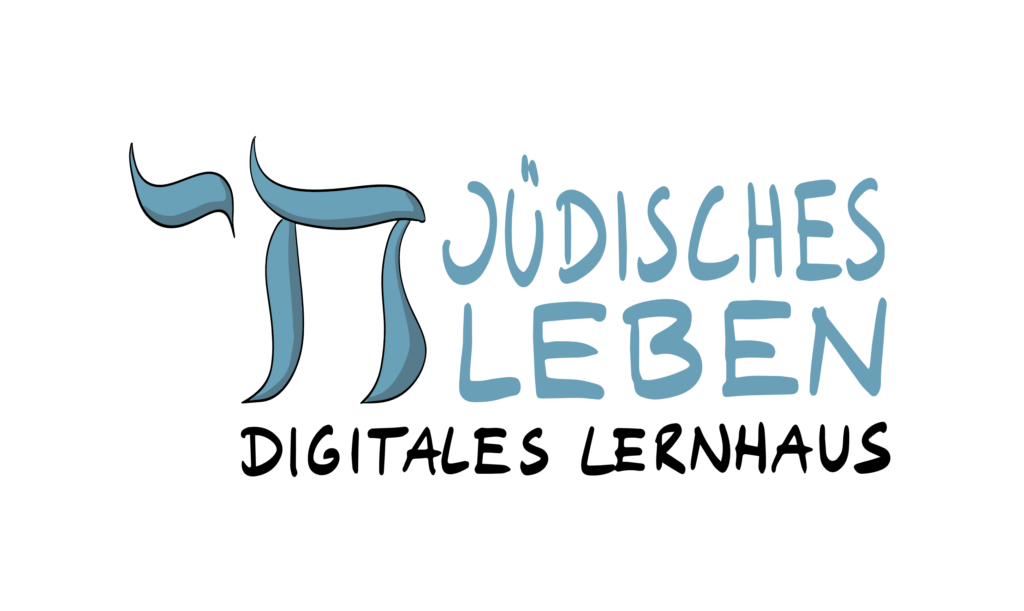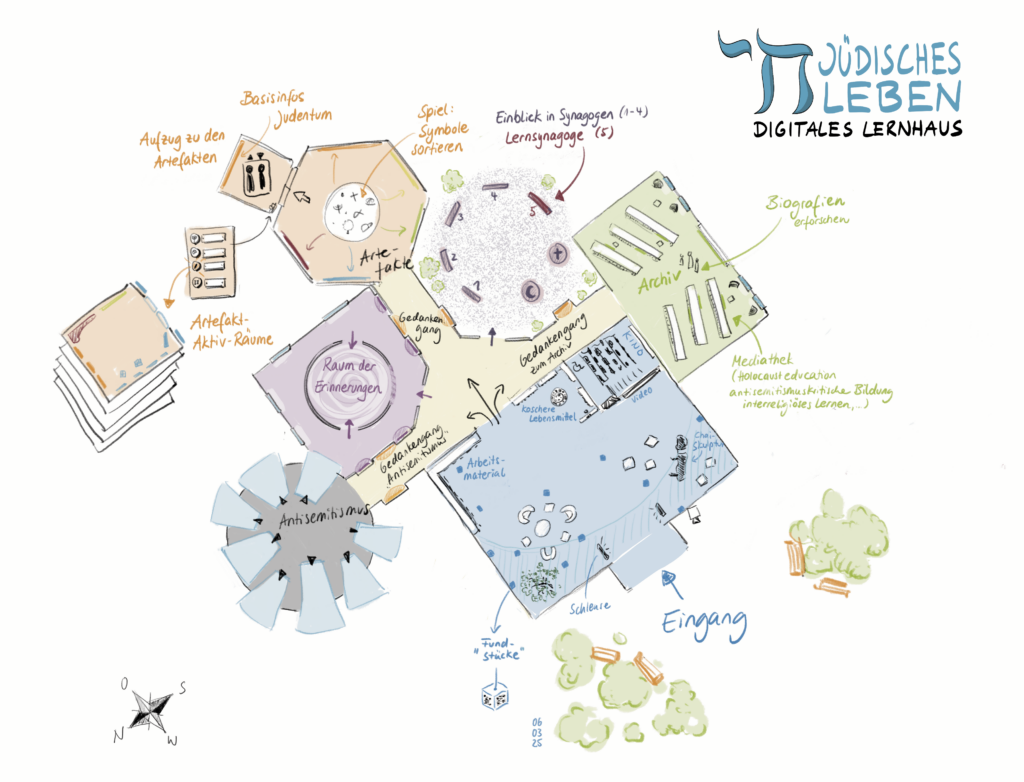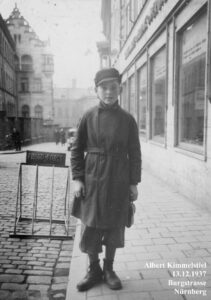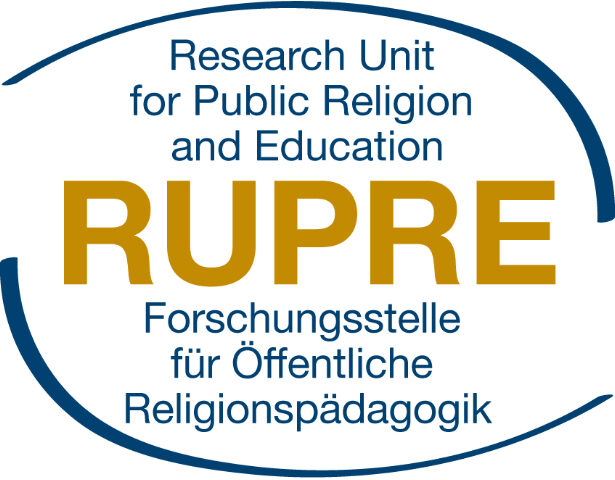Digitales Lernhaus “Jüdisches Leben”
 Digital Learning House “Jewish Life” – Concept
Digital Learning House “Jewish Life” – Concept
Brief description
With the digital learning centre “Jewish Life”, a sustainable learning offer is being created together with students and in interdisciplinary cooperation (didactics of Protestant religion, Protestant theology, didactics of history, school pedagogy), which – in addition to the usual emphasis on the history of suffering of Jews – focuses on the development of Jewish life in its cultural value and its diverse liveliness in Germany in the past and present. This is also intended to make an important contribution to the prevention of anti-Semitism.
Description of the initial situation
 The initial problems lie both in terms of content and methodology: Jewish life and anti-Semitism are consistently underrepresented in school and university teaching.
The initial problems lie both in terms of content and methodology: Jewish life and anti-Semitism are consistently underrepresented in school and university teaching.
Teachers and pupils have little knowledge of Jewish history and culture or of contemporary Jewish life in Germany (Salzborn & Kurth, Antisemitismus in der Schule, 2019). Furthermore, schools in particular are a focal point for anti-Semitic statements (Bernstein, Antisemitismus an Schulen in Deutschland, 2020, Unabhängiger Expertenkreis Anti-Semitism, 2017). In general, anti-Semitism is on the rise again in Germany. Antisemitic acts of violence are on the rise (FES, Verlorene Mitte, 2020). The echo chambers of the internet and public statements by right-wing parties serve as ideological amplifiers. The causes are manifold. However, one of them is likely to be that for many people, their “knowledge” about Judaism is fuelled by the media and deep-seated prejudices and resentments circulating online and offline, while only a few people have personal encounters with Jews. This is also due to the fact that there is only a relatively small Jewish minority in Germany (estimates range from 150,000 to 250,000 people). Added to this are stereotypical attitudes, some of which are characterised by centuries-old anti-Jewish images.
The media presence of Judaism in Germany is also largely dominated by the – important and still necessary – discussion of the Shoah and anti-Jewish European history. In contrast, the perception of the valuable cultural contributions of Judaism in the past and present as well as the diverse vitality of Judaism currently lived in Germany is given far too little attention (www.kmk-zentralratderjuden.de/gemeinsame-erklaerung).
The “Digital Learning Centre ‘Jewish Life'” aims to use a variety of digital possibilities to
a) present the aforementioned cultural contributions and basic information on religious Judaism
b) to explore current Jewish life in Germany from an experiential perspective, and
c) to identify and combat anti-Semitism in its various forms.
Description of the project idea
A core idea of the project in the university sector is the digital support of existing courses from various fields of study in cross-pillar cooperation (specialised didactics, subject sciences, pedagogy, school pedagogy) and supplementation. The cooperation with non-university and, above all, Jewish partners, including a growing amount of digital material on Jewish life, is also intended to highlight the diversity of Jewish self-understandings. The research orientation of teaching will be strengthened through research-based learning (Basten/Mertens/Schöning/Wolf, Forschendes Lernen in der Lehrer/innenbildung, 2020; Pirner/Rothgangel, Empirisch forschen in der Religionspädagogik. Ein Studienbuch für Studierende und Lehrkräfte, 2018; Bolland, Forschendes und biographisches Lernen in der Lehrerausbildung, 2011) with the help of digital formats (Kergel/Heidkamp, Forschendes Lernen mit digitalen Medien, 2015).

 One example of this is the establishment of a digital archive in which students process previously unrecorded rural Jewish archive holdings relating to the Medina Oschfah (former rabbinate of Schnaittach) (cataloguing, transcription, cataloguing, indexing, educational use); at the same time, the materials can serve as a resource for further historical and/or educational work (Switalski, Schalom Melanchton, 2016).
One example of this is the establishment of a digital archive in which students process previously unrecorded rural Jewish archive holdings relating to the Medina Oschfah (former rabbinate of Schnaittach) (cataloguing, transcription, cataloguing, indexing, educational use); at the same time, the materials can serve as a resource for further historical and/or educational work (Switalski, Schalom Melanchton, 2016).
In the field of religious didactics, a presentation of religious Jewish artefacts (Haußmann, Lernen mit religiösen Artefakten, 2008) should open up a wide range of opportunities for interreligious learning (ethnographic research into religious backgrounds and contexts of use). At the same time, digital formats can be used to open up opportunities for interaction that take the existing “objects” as a starting point for interreligious dialogues between different target groups.
Various manifestations of anti-Semitism are represented in a rotunda by images that can be explored using stimuli. You ‘enter’ the respective room through the opening images in order to further penetrate the complex of topics of this one manifestation of anti-Semitism and to develop it according to a certain pattern (explore manifestations – gain an overview – take a closer look – understand better – find ways out).
In addition to the area of university teaching (but also adult education), the focus is also on the school sector (primary and secondary level), so that the digital learning centre “Jewish Life” is designed on three levels, so to speak: children – young people – adults.
Pupils can move freely in the virtual rooms (drawn by Britta Wagner in graphic novel style) and work independently with the materials provided (inside perspective – outside perspective).
Poster Digitales-Lernhaus-Jüdisches Leben
Flyer Digitales-Lernhaus-Jüdisches Leben
The ‘Digitales Lernhaus “Jüdisches Leben”’ project is being developed in cooperation with BCJ.Bayern e.V. and the Gesellschaftswissenschaftliches Institut für Zukunftsfragen München (GIM). It is significantly supported by the Protestant Church in Bavaria and also by the FAU-Universitätsbund, the Bayerischer Lehrerinnen- und Lehrerverband and RUPRE.
